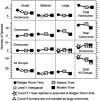Exceptional record of mid-Pleistocene vertebrates helps differentiate climatic from anthropogenic ecosystem perturbations
- PMID: 15197254
- PMCID: PMC438971
- DOI: 10.1073/pnas.0402592101
Exceptional record of mid-Pleistocene vertebrates helps differentiate climatic from anthropogenic ecosystem perturbations
Abstract
Mid-Pleistocene vertebrates in North America are scarce but important for recognizing the ecological effects of climatic change in the absence of humans. We report on a uniquely rich mid-Pleistocene vertebrate sequence from Porcupine Cave, Colorado, which records at least 127 species and the earliest appearances of 30 mammals and birds. By analyzing >20,000 mammal fossils in relation to modern species and independent climatic proxies, we determined how mammal communities reacted to presumed glacial-interglacial transitions between 1,000,000 and 600,000 years ago. We conclude that climatic warming primarily affected mammals of lower trophic and size categories, in contrast to documented human impacts on higher trophic and size categories historically. Despite changes in species composition and minor changes in small-mammal species richness evident at times of climatic change, overall structural stability of mammal communities persisted >600,000 years before human impacts.
Figures




References
-
- Bell, C. J., Lundelius, E. L., Jr., Barnosky, A. D., Graham, R. W., Lindsay, E. H., Ruez, D. R., Jr., Semken, H. A., Jr., Webb, S. D. & Zakrzewski, R. J. (2004) in Late Cretaceous and Cenozoic Mammals of North America: Biostratigraphy and Geochronology, ed. Woodburne, M. O. (Columbia Univ. Press, New York), pp. 232-314.
-
- Lundelius, E. L., Jr., Downs, T., Lindsay, H. A., Semken, H. A., Jr., Zakrzewski, R. J., Churcher, C. S., Harington, C. R., Schultz, G. E. & Webb, S. D. (1987) in Cenozoic Mammals of North America, ed. Woodburne, M. O. (Univ. of California Press, Berkeley), pp. 211-235.
-
- FAUNMAP Working Group (1996) Science 272, 1601-1606. - PubMed
-
- Martin, P. S. & Klein, R. G. (1984) Quaternary Extinctions: A Prehistoric Revolution (Univ. of Arizona Press, Tucson).
-
- Alroy, J. (2001) Science 292, 1893-1896. - PubMed

